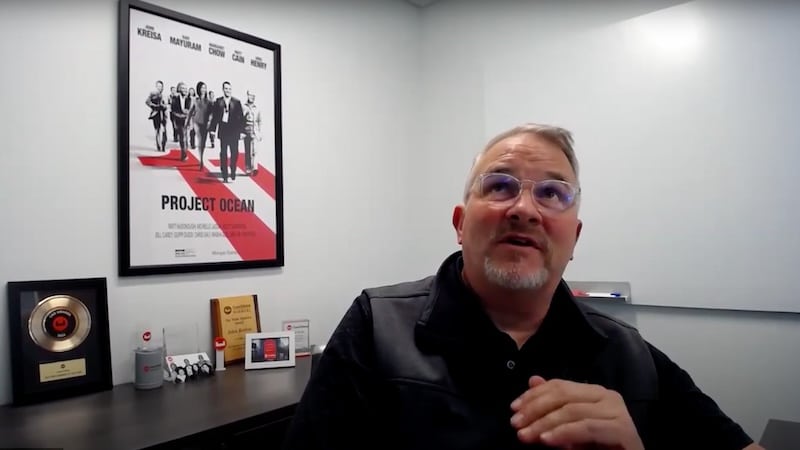Data-Sleek founder and CEO Franck Leveneur made a guest appearance alongside Couchbase CMO John Kreisa on DM Radio’s Really Real-Time Data, hosted by Eric Kavanagh. During the interview, Leveneur, Kavanagh, and Kreisa discussed the importance of data management, gave their opinions about today’s real-time data landscape, and discussed the future of AI in business.
This excerpt is a continuation of the interview that explores the concept of Retrieval Augmented Generation (RAG), where large language models (LLM) are integrated into workflows alongside traditional databases. These models enable hybrid search and adaptive applications.
Kreisa makes some interesting points about how LLMs can handle semantic queries that combine deterministic data from databases to deliver hyper-personalized experiences. Leveneur envisions AI-driven automation in enterprise infrastructure, with virtual assistants monitoring systems, identifying issues, and taking action based on real-time data.
The guests further explored Leveneur’s exhortation to choose the right database for a company’s needs, which was mentioned in the previous segment. Kreisa and Leveneur consider this choice’s factors and challenges, such as performance, data types, redundancy, and vendor focus. Kreisa advocates for a client-centric approach that sacrifices skill for value. Leveneur advocates for choosing a vendor that focuses on the quality of the product over the quantity of services offered.
The discussion highlights the potential of augmented workflows and the evolving role of databases. Enabling real-time, personalized experiences through the integration of AI and traditional data management systems proves to be the next logical step for data management.
Key Takeaways
- LLMs are distilled down to probabilistic math. You’re never going to get 100% perfect scores on certain things.
- Merging AI with automation in the enterprise and interacting with other systems that must be online to provide real-time data is on the horizon.
- Choosing the right database involves thoughtful consideration and the balance between organizational needs, expertise, and value.
Real-Time Data Landscape Interview: Segment 2
Host: Eric Kavanagh
Guests: Franck Leveneur (Founder, Data-Sleek), John Kreisa (CMO, Couchbase)
Broadcasted May 23, 2024
Find the full podcast on DM-Radio.Biz Here.
Read Part 1 of this interview:
Read Part 3 of this interview:
Read Part 4 of this interview:
Retrieval Augmented Generation (RAG) and Its Role in Enterprises
Eric Kavanagh: All right folks, back here on DM radio talking to a couple data experts. We’ve got John Kreisa, CMO of Couchbase and Franck Leveneur, the principal over at Data-Sleek, and we’re talking all about real-time data, data workflows, how data fuels all these different systems.

In the break, John, you mentioned a very interesting point. It reminds me of one of my thought processes around all this. These large language models are going to increasingly be part of a workflow. Not just a sort of be-all, end-all solution unto themselves, because we all know that’s not what you want to be doing with these things. They’re going to become part of systems.
The Process of Retrieval Augmented Generation
You have this whole concept of RAG, this retrieval-augmented generation, where everyone is jumping on RAG now. From what I understand, it came out of Meta, and they realize that because these LLMs are distilled down to probabilistic math, you’re never going to get 100% perfect scores on certain things.
You’re always going to get hallucinations, as they call them. Errors, as another one of my friends in the business call it, not hallucinating. It’s just an error. It made something up. And where it makes things up is typically on the fringe.
Remember, there are consensus engines so anything, any topic that has been widely published or written about on the interwebs on which the models were trained, it’s going to do a good job about breaking that stuff down.
How radiators work, how heating systems work, how HVAC works. Stuff that’s been heavily published about, you could get an average of all those bits and pieces out there and cobble together a very compelling and very accurate storyline. On the fringe, not so much.
So think about individual people’s names. If someone is not very popular, has not been written about much on the web, they’re not going to do a very good job of that. I think I remember ChatGPT told me I’d written two books. I was like are you sure? Is that like in the future, you seeing what’s happening? Like is that how powerful you are, the future I write this book? But the point is they are very powerful in certain ways. John I’ll throw this over to you.
I think we’re going to start seeing workflows where they are part of the workflow. But then in your RAG model, or somewhere in the context, you have your traditional column or databases giving you deterministic data, for example.
You’re going to have UIs and other things that are around it so it becomes a component part of the big picture, creating what you folks call adaptive apps. Tell us about those and how this all comes together.
Enabling Hybrid Search and Adaptive Applications
John Kreisa: Yeah, thank you. It is in that combination because traditionally operational applications, which were very deterministic on what they were doing, and with the generative AI capability semantic pieces, it adds very interesting capabilities to the applications. It allows you to create, I think, what’s being called “hybrid search” now, where you combine Bing the two together to give that kind of experience.
There’s a couple different pieces in here. You can imagine trying to solve a problem in an application where it’s based on where this person is. It’s a geographic search. And they’re querying for a set of shoes that would fit them. They know what the size is, so they’re giving very deterministic size.
Maybe they also know something else about them. They’re for sports, they’re running shoes. They know some things that are deterministic about it. But they want it to be a certain color, they want to match a pair of pants that they have, right? So they say ‘match this color.’ Well that becomes more semantic.
So then that’s where the semantic piece turns over and goes, it’s not just blue, but I want to match this shade of blue exactly. That’s where you get these more combination or hybrid search pieces to create these adaptive applications. They can adapt based on the geography. You know, within 20 miles of where I am right now, where can I find these shoes?
It gives that level of flexibility with the hyper personalization and combines that deterministic search SQL query capability, which we’re all familiar with, with the vector search capability that is being added to databases everywhere.
The Future of AI and Automation in the Enterprise
Eric Kavanagh: Yeah I think so too. Franck I’ll bring you into that conversation as well. I think increasingly you’re going to see these various bits and pieces form workflows and these large language models and other foundational models are going to be a crucial part probably on the front end, but also to a certain degree in the back end. It just depends on the use case. But you’re going to be pulling them into workflows that could become very powerful and very adaptive, as John suggests. What do you think about that, Franck?
AI-Driven Automation for Enterprise Infrastructure
Franck Leveneur: Yeah, definitely. I use ChatGPT quite often. I ask questions that are very specific to what I do, and I’m surprised about the knowledge of the AI, what answers it gets, suggestions, solutions, and of course programming. But more specifically, to what I do.

I think it’s still going to be a couple of years, but if you combine AI with automation and build an internal RAG in the enterprise about the entire infrastructure of the company, you can have a virtual DBA or a virtual assistant admin that can monitor everything. As soon as there’s something wrong that happens, it knows. It can identify the alert, and what it is. It can query another database to make sure the application is running or there’s something, and then maybe can send a command to spin up a new server. Basically, bring the application back online.
I think you know it’s going to be multiple applications in analytics, definitely. Because ChatGPT already does that. You can give it a diagram or a table, and it will analyze the data for you and summarize it for you. That’s already a given. But I think merging AI with automation in the enterprise, and interacting with other systems, that has to be online all the time and that has to provide real-time data all the time. I think that’s going to happen very soon.
Choosing the Right Database for Workflow Integration
Eric Kavanagh: Yeah I know it’s happening very very quickly and maybe John I’ll throw this over to you. It’s got to be exciting and a bit nerve-wracking to be a CIO or a CTO these days.
How do you counsel your clients and keep them focused on what really matters? There are so many distractions now. It’s so easy to get all these ideas, but at the end of the day, the trains have to run on time and business has to get done. How do you counsel your clients to stay focused and keep improving but not go too far out on a limb somewhere?
Consultative Approach to Adopting AI
John Kreisa: Yeah I think it’s a great question. I think it’s one it’s It’s always important to remind everybody and ourselves that we’re very early in this overall transition. Specifically vis a vis, you know AI and kind of the technology that the landscape is so dynamic in terms of the vendors.
What’s happening is that during this podcast, something will have changed in terms of how quickly the Market’s moving. Our advice is, things are definitely moving fast. I think in terms of areas where you can get incremental Improvement as a first, if you look at some of the first implementations, it’s been chatbots. You know, code assistance, things like that, where people are getting the initial value, but the longer piece is what you were saying, which is in the workflows.
‘How do I improve and integrate into workflows, which make workers more efficient in the things they do? If I’m a service agent who’s servicing clients, or in a storefront, we have big customers like Louis Vuitton who have in-store applications that they’ve built on top of Couchbase.How would they go about including AI into that, it’s a consultative process.
Talking to them about trial and setting up end of trial servers, and applications, envisioning how they would see that impacting the end users that they want to do, and what information is needed. It’s a ton of information architecture.
I’m sure you know Franck can talk about it, you know, ad nauseum in terms of the thinking about the data architecture that has to go behind enabling some of these things. Very early on in the transition, it’s a multi-year transition for sure. So yes, keep the applications running that are mission critical but look for ways to incrementally add value.
How Your Company Can Choose the Right Database For Their Business Goals
Eric Kavanagh: you know Franck I’ll send this one over to you as you suggested, migrating off a database is very, very painful you want to get it right the first time get the right database, and then stick to it because it’s going to be painful.
How do you work with clients to identify out of it? I just looked it up, 420 different databases that are considered mature and functional, enterprise-capable according to DB engines. It’s DB-engines.com. That’s a lot of choices out there. It’s almost an embarrassment of riches.
How do you work with clients to figure out, first of all, the shortlist, and then make that final decision? What are some thoughts or insights you can offer the audience?
Advice From A Seasoned Database Expert
Franck Leveneur: Well, I would say the database engine is almost like a car engine or a transportation engine. There are some that are very fast. I would compare that maybe to a memory engine. There are some that are not fast, but they carry a lot. They can handle maybe like a data way, lots of data, because they store the data in different ways.
So you need to look at what your application needs to do first. Do you need high concurrency and a very fast response? What kind of data are you storing? Is it a key-value pair? Are you storing transactions? Do you need redundancy?
If your memory server goes down, you lose the data. Do you want to store that in a regular database where it goes to disk? So there’s all these questions that you need to think about.
I know there are a lot of databases, but there are also very few that do things very well. They’ve been doing it for a long time. We were talking about Oracle, IBM, right? They’ve been in the business for a long time. Snowflake, well, they caught up now. It’s the data warehouse in the cloud. It’s very hard to compete with them. That’s the only thing they focus on. That’s their thing.
A lot of companies they focus on, many I would say, like AWS for example, they focus on many services so it’s hard. Their products are good, but they are not great. Snowflake, that’s what they focus on. Couchbase, same. That’s what they focus on. So they spend all their research and and development in that to to develop their product.
Choosing the right database engine is not easy, you need to sit down and think, and sometimes, maybe you need two, or maybe three database engines. And it’s okay. You don’t need to run everything on the same database. First of all, it creates issues if your database goes down, everything goes down. It’s good to also spread the risk and use the right database engine for the right purpose or what you’re trying to achieve.
Key Considerations for Choosing the Right Database
Eric Kavanagh: Yeah and let’s see, I guess I’ll throw this one over to John. Again on this topic of choosing the right database, because you do not want to have to switch out databases. It’s just absolutely brutal, especially if it’s for a transactional system. I mean, analytical it’s not that big of a deal. But transactional is a very, very, very big deal.
What are some of the key considerations? Obviously functionality and fit for purpose, but also cost, license cost, road map of the vendor, like where they’re going, how much they work with customers?
Franck mentioned AWS. I heard an interesting comment from an analyst a few years ago about AWS. Because I’ve gone into that environment, looked around and it’s almost like walking into a Home Depot, like stuff everywhere, like oh my god, what is all this stuff? What do I do?
And he said the reason for that is because AWS, in their ethic, in their ethos, they work very, very closely with customers to create bespoke solutions. When you do that, you’re going to wind up with lots, and lots of different services that can be cobbled together in various ways.
There are all these different factors and, of course, you’re an onsite team, like who do you have on your team to manage this stuff? Yeah DBAs aren’t quite what they used to be, but you still need people who know how to run these things, how to stand them up, how to restart them, all that stuff. How do you counsel clients on figuring out what works best you know what are the horses for which courses, basically?
Taking On A Client-Centric Approach
John Kreisa: I think we take an approach which is very client-centric. Looking at the requirements that they have for their application. We offer a multi-purpose database, which has in memory capability and multiple functionalities there. It’s a matter of just working with them and understanding what the requirements are, that they have scalability requirements, multi Cloud requirements.

We offer a database and platform that extends to the edge, working offline and online. So it’s really just digging into what kind of problem are you trying to solve, and then working with them to tweak the details, on Couchbase, anyway.To make sure that if it’s scale out architecture, or heavy query workload, or heavy workload, like whatever it might be, so that we’re leaning into and making sure that they’re getting the most out of the database.
Focusing On Value and Simplifying Architecture
But you like you said, skills are big. I think from our standpoint, Couchbase Capella is a hosted database, so we’re running it for them. We sort of take some of that away in terms of the skills and allow them to focus on the unique value that they want and the applications they build.
There’s all those, the API, the other systems, that needs to tie into these data architectures. Again, I’m sure as Franck knows and yourself, can be very very complex. So we do believe that a platform with multi-purpose capabilities can simplify the architecture.
I’ll give you an example which is, for us, we believe vector search capability is a feature of a multi-purpose database, not a category itself. You do get into moving data around between systems where operational databases are the source of truth. In many cases.
Finding Value in Vector Databases
Eric Kavanagh: Yeah that’s a good point. That’s a very good point. In fact, I do think that there is a lot of value in these vector searches in being able to do that discovery-oriented work to understand how things align.
I read an article the other day on LinkedIn where some guy was talking about how he connected his LLM to his data sources and then was using it as the front end, and saying “Hey run me a query on how many widgets we store in this environment in this period of time.” It reached into the database, executed the query, brought back the information, and delivered. It’s like, wow, yeah, wait a second.
Now I don’t know what the footprint of that is. We don’t know. There are many, many other shoes to drop in this game. But we’ll pick that up after the break. Folks, we’ll be right back. You’re listening to DM radio.
[Break]
This interview has been edited lightly for clarity.
Find the full podcast on DM-Radio.Biz Here.
Jump to Part 1 of this interview:
Jump to Part 3 of this interview:
Jump to Part 4 of this interview:
Want to host Data-Sleek on your next podcast? Contact us for our speaker sheet and to set up a free consultation about vector databases or real time analytics.


